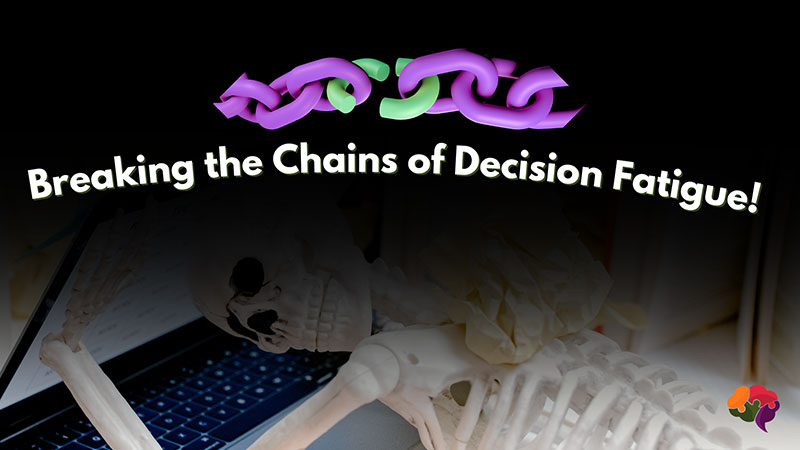In the realm of contemporary marketing, a subtle adversary often prowls in the shadows, quietly undermining even the most robust of marketing strategies. No, it isn’t the extravagant costs associated with airing a Superbowl commercial; it’s something far more pervasive. Truth be told, you are experiencing it right now as you choose to read further or go in search of greener virtual pastures. This formidable foe is none other than “decision fatigue.”
In our daily lives, we wade through a tsunami of choices, from selecting outfits, hairstyles, and dinner options to choosing coffee shops and which route we take to soccer practice. The collective weight of these decisions can leave us mentally drained, seeping into our online engagements and creating a fierce hurdle for businesses striving to convert prospects into loyal customers.
The Overwhelming Deluge of Media
In our hyperconnected world, consumers are bombarded with an avalanche of information and choices at every turn. From endless social media content to overflowing email inboxes, the sheer volume of media we encounter can be daunting. In this crowded digital landscape, businesses must refrain from contributing to the chaos.
The Toll of Cumulative Choices
Every choice we make, no matter how small, consumes cognitive resources. From selecting the right Instagram filter to choosing which news article to read, each decision chips away at our mental energy. As the day progresses, our cognitive reserves deplete, leaving us susceptible to decision fatigue.
Decision Fatigue’s Impact on Conversion and Return Visits
Decision fatigue carries far-reaching consequences, affecting not only immediate conversion rates but also putting a damper on the likelihood of users returning to your website or engaging with your brand again. It can result in a poor user experience as overwhelmed users navigating complex choices may become frustrated, leading to decreased satisfaction and engagement with a website or application. Consequently, poor user experiences often lead to missed conversion opportunities and higher costs to you and your business in the long run.
Consider the statistics:
- According to a study by the Baymard Institute, the average cart abandonment rate across e-commerce websites is a staggering 69.57%. A significant portion of these abandonments can be attributed to difficulties in the decision-making process caused by complex UX design.
- In another report by Akamai, 53% of mobile site visitors will leave a page that takes longer than three seconds to load. Slow loading times can contribute significantly to a poor user experience, thus resulting in high bounce rates.
The Competitive Threat
Even more concerning is the competitive threat posed by poor user experiences. When users leave your site frustrated, they aren’t likely to forget their negative encounters. Instead, they may actively seek out competitors offering a more seamless experience.
Consider the following: a user searches for a specific product or service on your website but struggles to find it due to convoluted navigation or misleading links. Frustrated and dissatisfied, they leave your site and visit a competitor’s site that offers a similar product. If the competitor’s site provides a smoother user experience, they will likely convert there.
Conversions can be hard enough to secure; your site’s content and ease of usability must capitalize on every facility possible.
Adding Insult to Injury
Consider a scenario where the long-standing presence of your website has garnered a substantial amount of organic traffic. Undoubtedly, this influx of visitors is translating into a sufficient number of conversions. At first glance, this might appear to be a promising situation; however, it’s essential to evaluate the term ‘sufficient’ here. While your conversion rates are satisfactory, they are merely meeting the baseline and not necessarily soaring to the levels of excellence or surpassing predefined objectives. In essence, your website’s performance can be described as functional but not exceptional.
What can be particularly disheartening is the realization that your competitors are strategically targeting the very traffic that frequents your website. They recognize that your platform is attracting their potential customers. Consequently, they launch targeted advertising campaigns, cleverly designed to intercept your visitors after they have visited your site and subsequently departed without converting. This phenomenon is akin to a well-aimed punch to the gut while you have your head turned.
Concrete statistics underscore the implications of this competitive maneuver:
- The Retargeting Advantage:
- Studies show that retargeting, the practice of displaying ads to users who have previously visited a website, can yield substantial returns. According to Google, retargeting can increase ad engagement rates by up to 400%.
- Competitive Retargeting:
- In the intensely competitive digital world, it’s worth noting that businesses allocate a significant portion of their advertising budgets to retargeting campaigns. On average, businesses devote about 15% of their ad spend to retargeting efforts, as reported by eMarketer.
- Winning back visitors who competitors have successfully retargeted can be a costly endeavor. Conversion rate optimization (CRO) efforts to re-engage these users often come at a premium, as businesses may need to outbid competitors in the advertising auction to regain their audience’s attention.
It becomes evident that maintaining a ‘sufficient’ level of conversion performance may not be enough to safeguard against the determined efforts of competitors. The dynamic nature of digital marketing calls for continual optimization and strategic innovation to elevate your website’s performance from ‘sufficient’ to ‘outstanding.’ In doing so, you retain your existing customer base and fortify your defenses against the ever-present competitive threat.
Expanding on The Competitive Threat:
Due to the fiercely competitive nature of modern marketing, the consequences of allowing poor user experiences to persist reach beyond the immediate challenge of conversion. Let’s delve deeper into the potential costs associated with reacquiring users who have abandoned their journey due to these frustrations. This aspect of the digital world warrants careful consideration, as it encompasses both the financial and strategic implications.
The Expensive Reality of Reacquisition
Reacquiring users who were initially interested but who left due to a suboptimal user experience can be a financially taxing endeavor. It typically entails the implementation of retargeting strategies, a proven method to re-engage potential customers. However, this effectiveness comes at a premium cost.
The Cost of Delay
Time is a crucial factor when it comes to reacquisition. The longer the issues on your website causing decision fatigue persist, the higher the cost of reacquiring the same users becomes. As your once-potential conversion ventures into the digital realm seeking alternatives, your competitors may seize the opportunity to capture these disenchanted prospects.
In this fierce battle for the attention and loyalty of digital consumers, businesses must understand that retaining users on their websites is just the beginning. It’s imperative to ensure that each user departs not merely as a visitor but as a satisfied, eager-to-return customer. The key lies in offering a user experience that eliminates any hurdles or barriers to conversion.
Statistics Paint a Clear Picture
Statistics emphasize the undeniable cost of subpar user experiences. Consider this:
- Research indicates that users are 88% less likely to return to a website after a poor experience. This stresses the critical importance of not just attracting users but ensuring they leave with a positive impression.
- According to a study by the Aberdeen Group, companies that prioritize user experience design achieve up to a 100% higher year-over-year increase in revenue compared to their competitors.
In light of these figures, it becomes evident that investing in a user-centric approach is not merely a marketing strategy; it is an absolute necessity for long-term success in the highly competitive world of digital marketing.
By prioritizing the user experience, you not only elevate immediate conversion rates but also fortify your defenses against the relentless allure of competitors. Ultimately, this approach maximizes your Return on Investment (ROI) and bolsters your position in the ever-challenging world of multi-platform marketing.
At the End of the Day
In the face of decision fatigue, crafting user experiences that simplify, engage, and guide users becomes not just a strategy but a necessity. It is paramount to prioritize your potential customer’s journey and user experience in the name of optimizing their mental reserve. The numbers reflect that a seamless user experience promises to boost immediate conversion rates and fortify defenses against competitors.
In today’s digital landscape, where freedom guides our consumer choices, a website’s optimal performance stands as the beacon. When a site swiftly transitions users from ‘love at first sight’ to ‘thank you for your order,’ data consistently reflects that users favor platforms that expertly navigate their journey. Your role is pivotal; positioning your business as a leader in the competitive realm of multi-platform marketing hinges on sidestepping the pitfalls of complex user interfaces and sluggish sites. Doing so alleviates the burden of decision fatigue and empowers users to engage seamlessly.
Do your part to combat the effects of decision fatigue by revolutionizing the digital landscape: Prioritize UX. Elevate conversions. Maximize ROI.


0 Comments